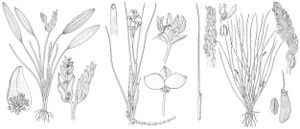Lilaea
in A. von Humboldt and A. J. Bonpland,Plantae Aequinoctiales 1: 221. 1808.
| Taxon | Illustrator ⠉ | |
|---|---|---|
 | Scheuchzeria palustris Aponogeton distachyos Lilaea scilloides | John Myers John Myers John Myers |
Herbs, annual. Roots without terminal tubers. Rhizomes slender, short. Leaves erect, terete, with aerenchyma tissue; sheath with ligule free. Inflorescences both scapose and sessile; spikelike racemes or solitary flowers; scapes shorter than leaves, terminated by spikes; spikes racemes with pistillate flowers near base, bisexual medially, staminate proximally; sessile inflorescences 2 or more, with solitary flowers pistillate flower only, 2 or more, sessile. Flowers bisexual and unisexual, to 5 types, sessile; tepals 0–1, green, linear; stamens 0–1; anthers sessile; pistils 1; ovules 1. Bisexual and staminate flowers: tepal present. Pistillate flowers: tepal present, style 0.5–2 mm or tepal absent, style 0.2–30 cm. Fruits nutlets, angular, beaked.
Distribution
North America, Central America, South America
Discussion
Species 1.
Selected References
None.
Lower Taxa
"not elongating" is not a number.